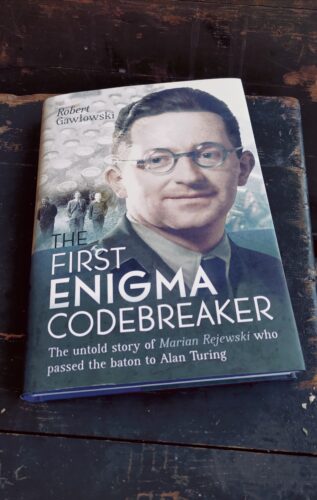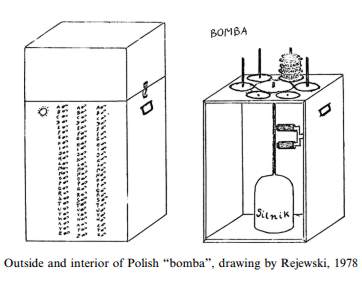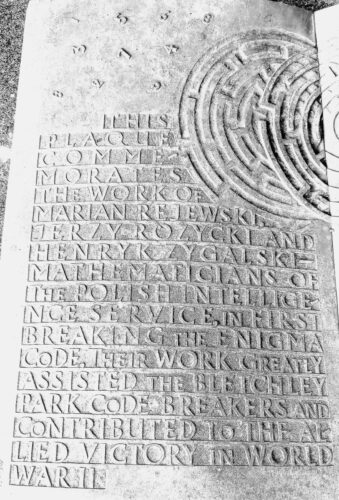A management professor at WSB University in Bydgoszcz, Poland has published an impressive biography of the amazing codebreaker Marian Rejewski. We are very fortunate since Rejewski largely has been completely ignored by Americans and British who have fixated and over-sensationalized another man (Alan Turing).

The First Enigma Codebreaker:
Marian Rejewski Who Passed the Baton to Alan Turing
By Robert GawlowskiPublished: April 15, 2023
ISBN-10: 1399069101
ISBN-13: 9781399069106
Pen and Sword Military
The fact that this book is promoted by the U.S. Naval Institute says to me people who really know codebreaking, and the balance of secrecy with integrity, are trying to get the word out.
The fact that Robert Gawlowski comes from the same hometown as Marian Rejewski… well, you get the idea.
Alan Turing’s story is important. It should be known, not least of all because he was killed by his own government due to ignorance and bias. But telling the sad Turing tale also shouldn’t take away from the fact that Rejewski and many, many others have very important stories to be known as well.
And I don’t mean just rehashing French military literature of the 1970s, as it were. Gawlowski brings a distinctly Polish perspective to the story of a Polish war hero, challenging British dominance over English storytelling.
Rejewski was unquestionably the first person to break the German Enigma, and also a man who kept the utmost secrecy for years, which undermined his reputation of being the first. Note the complete absence of credit in articles like this one:
Among the academics were great figures in the history of computer science, not least Max Newman, whose lectures Alan Turing attended at Cambridge University. Newman’s work at Bletchley was critical to cracking the “Tunny” code used by the German High Command. Convinced that codebreaking could be mechanised, he was a driving force in the creation of Colossus, the world’s first programmable computer. It was the remarkable technological breakthroughs of Newman, Turing, Welchman and others that the scholar George Steiner had in mind when he described Bletchley as perhaps the greatest achievement of Britain not just in the Second World War but in the 20th Century.
Newman was convinced codebreaking could be mechanised because Rejewski already proved it to be true with his early cyclometer and then a 1938 “Bomba”… before Bletchley Park even existed.
Poland’s decryption work was so superior to Nazi military intelligence, while remaining entirely unknown, that the British on first glance basically refused to believe that Rejewski’s team could be so very far ahead of everyone else in the world. It’s not hard to imagine in that context why the Polish distrusted British intelligence, let alone the French.
For reference, here’s a quick recap of a timeline showing where clever Poles entered the fray relative to the late arrival of British interest:
- 1918 Arthur Sherbius’ proposal for rotor-based encryption device is denied by the German Navy
- 1923 Sherbius founds a company that markets his encryption proposal as a machine for privacy of banks and post offices
- 1926 The German Navy starts using one version of Sherbius’ machine
- 1927 The German Army starts using another version of Sherbius’ machine
- 1928 The Polish Ciper Bureau acquires a commercial version of Sherbius’ machine
- 1929 Poznan University runs a cryptography course, where three students stand out in the exams: Marian Rejewski, Henryk Zygalski and Jerzy Rozycki
You should be asking at this point where are the British in 1928, given that Germany is known to be using Sherbius’ machines in Navy and Army communication. Indeed, the British seem to have been primarily interested in the use of such machines by Spain and Italy.
Germany was not investigated by the British with the same serious urgency as in Poland, or France for that matter. In fact by the end of 1931 the French Intelligence had a mole in the German signals service with the codename Asche (Hans Thilo Schmidt).
Polish and French attention to German encryption is critical to understand because in 1932 Germany introduced the Enigma I — the foundation of its rotor-based Sherbius’ machines throughout WWII. That was also the year Marian Rejewski, not the British or French, created a dedicated effort (operated in Warsaw General Staff HQ) to break Germany’s Enigma I.
Nearing the end of 1932, as the French begin sharing Asche briefs with Polish intelligence, Rejewski already has been decoding Nazi military communications. He successfully calculated Enigma I wiring of its rotors.
Henryk Zygalski and Jerzy Rozycki join his efforts the following year. Poland in 1933, as Nazis violently seize power, is now producing exact replicas of the German military Enigma. The Polish Cipher Bureau achieves nearly 80% success with intercepted messages. They pioneer Enigma codebreaking such as a method that British working at Bletchley Park would later simply call their “Zygalski Sheet”.
You should be asking at this point where are the British in 1933, given that Nazis are an obvious threat and the German Enigma has been broken by the Polish. Sadly, I have to repeat the point above, the British seem to have been primarily interested in the use of such machines by Spain and Italy.
Poland continues to improve their methods such that by 1937 a high security codebraking compound is running in the remote wooded area south of Warsaw (foreshadowing Bletchley Park). This is where Rejewski’s team invents the incredible Bomba Kryptologiczna for automated brute-forcing of Enigma keys.
Newman’s later thoughts about automation, presented by the British as their own greatest moment of history, were quite clearly based on the prior work of Poland.

The threat from Nazi Germany becomes so clear that on January 9th, 1939 France and Poland try to meet with British intelligence in Paris. Trust is weak and little is accomplished. Another attempt is made 27th July when the Polish invite the British and French into the compound, exposing the Bomba decryption automation machine.
After the second meeting, with far more disclosures of how far ahead the Polish are, the British and French each receive a dump with documentation of the Engima along with a replica machine made by Poland. The speedup comes because in August of 1939 Poland knew it was running out of time and had to take risks, while also never exposing how much it knew.
One week after Germany and the Soviet Union signed the poisonous Molotov–Ribbentrop Pact to collaborate on destruction of Poland, the Nazi invasion begins 1 September 1939. As Poland is overrun by Nazi troops the British establish an Enigma Research Section at Bletchley Park.
Late? Better than never.
More to the point, in January 1940 the center of codebreaking had shifted to Paris briefly. For example the Zygalski Sheet was used by Alan Turing, who had traveled to Paris to learn Polish Cipher Bureau methods, as such training was no longer possible in Poland. The Nazi invasion into Denmark and Norway in April and early May 1940 foreshadowed the 10th of May invasion of France. Thus Polish codebreaking methods, increasingly in the hands of the British including Turing, reverted across the Channel to relative safety from further Nazi disruption.
The British replication of Polish intelligence operations after 1939 Warsaw and then again after 1940 Paris makes sense, in retrospect looking at the Nazi invasion maps, yet it almost never is told as such.
Bletchley Park became known as the wartime codebreaking operation because it survived better than Warsaw or Paris. It’s only lately that people have started to ask why and how the original Enigma codebreakers Zygalski, Rozycki and especially Rejewski were for so long completely cut out of the picture by British story-tellers. I mean think hard about the fact that Zygalski, Rozycki and especially Rejewski were not given much help themselves, neither spirited away nor housed in the relative secrecy and safety of Bletchley Park.
Supposedly the first big reveal of Bletchley Park, which sparked a boom in international attention, came from a single RAF officer spilling the beans in the 1970s. He intentionally omitted the Polish from his story of British superiority, due to his own basic bigotry. It’s taken a long while to undo that unfortunate inertia. Bletchley Park itself has done a lot over the years to bring the Polish story up to the front and center.

This book fits in well to the growing body of literature about who really was doing what, where and when, to defeat the technologically inferior Nazi operations. Even though the book has a few curious historical errors and omissions, it provides perspective with fascinating personal details of an important figure in security history. It is a very overdue and welcome addition to the study of WWI and WWII.
Bottom line is whenever someone brings up the Enigma, ask them if they mean the one made by Rejewski. If they reply “who”… you now know what to do.
In 2018 Dermot Turing, a nephew of Alan Turing, published “X Y & Z: The Real Story of How Enigma Was Broken”. It is mostly about code-breakers from Poland.
See more on https://dermotturing.com/